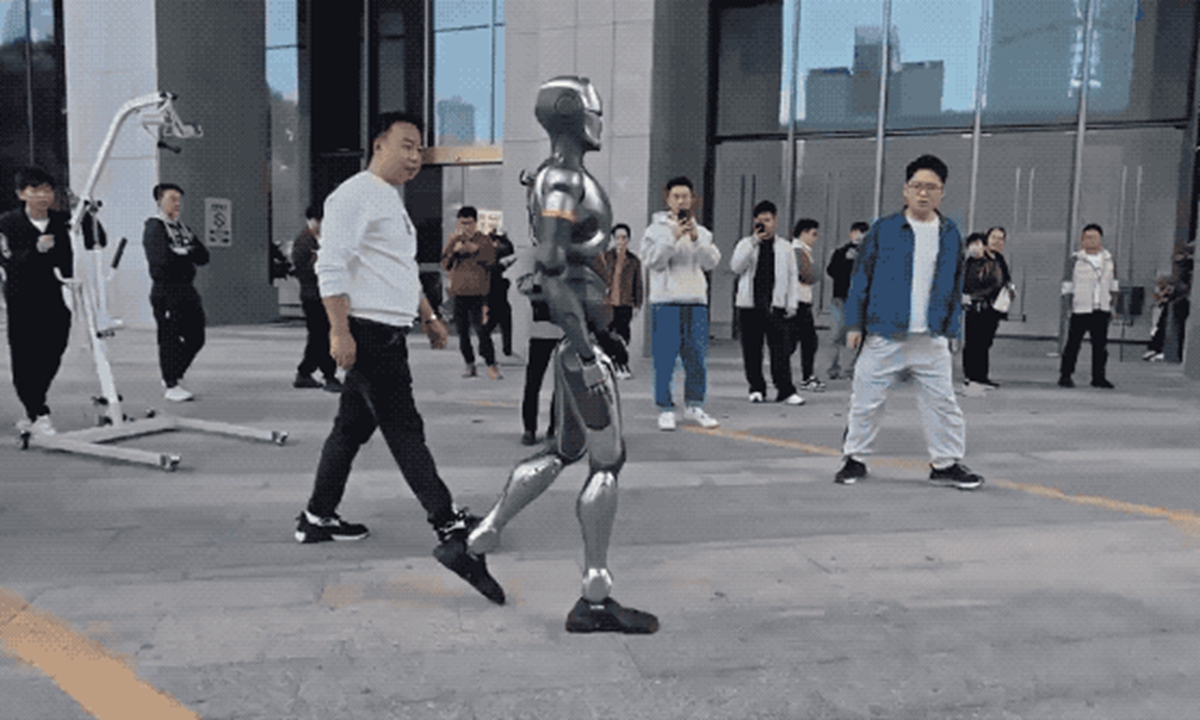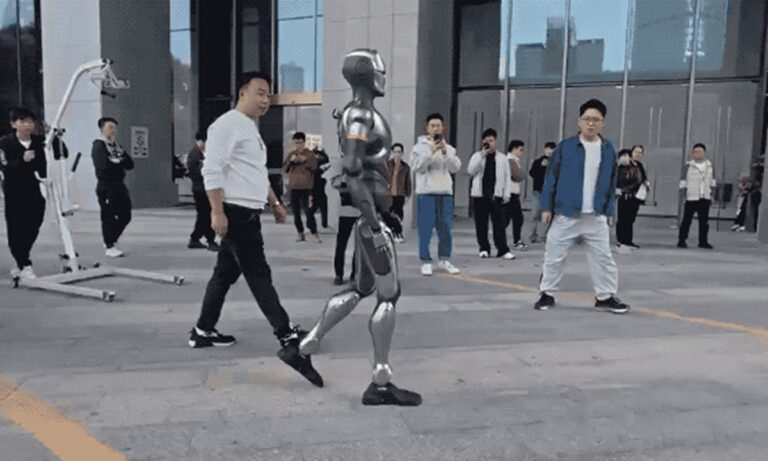
Humanoid robots walk on agile and fluid stairs on the streets of Shenzhen. Photo: Screenshot
The artificial intelligence (AI) robot has gained traction in Shenzhen, Guangdong Province, South China, and humanoid robots in Nanshan district currently function as grid-based community workers and police officers. Powered by Deepseek’s advanced, large-scale language model, AI technology is used in the Fution district, enhancing administrative governance and improving public services.
The video, released on Monday by Guangdong Radio and TV’s Chudian’s new media platform, shows the 1.38-meter humanoid robot that will help unify grid-based community workers’ patrols and inspections. Waving to the hands and crowd with officers.
The robot is developed by Shenzhen Engineai Robotics Technology Co. A company representative told Global Times on Monday that the robots featured in the video are one of three humanoid models launched by the company. The latest version of PM01 is equipped with optimized algorithms for improved stability and real-world performance.
According to the Shenzhen Government website, during the spring festival holidays, humanoid robots equipped with police forces accompanied officers on patrols on the streets.
The PM01 is 1.38cm tall and weighs approximately 40 kilograms, and has 24 degrees of freedom (DOF) and achieves a moving speed of 2 meters per second. Equipped with a 320-degree rotating motor at the waist, it allows you to perform a wide range of complex movements. The robot has two walking modes: mechanical walking and natural humanoid walking, he told Global Times.
This is not the first time a robot has been used for grassroots governance. Previously, a humanoid robot standing at a height of 170 centimeters and walking on agile and fluid stairs on the streets of Shenzhen went viral. According to a video posted by the official Southwest Government account, the robot, SE01, was also developed by the same company.
According to Engineai Robotics technology, the SE01 can perform human-like actions such as squatting, push-ups, spinning, grabbing, running. For the first time in the world, we have overcome the challenge of achieving natural, human-like walking movements. This breakthrough eliminates the troublesome small steps, bent legs and stomping movements common in other robots, allowing for smoother, faster, more stable and elegant walking.
Many netizens cried out, “The robot’s walking movements are very natural and realistic!” Others say that as grid workers face the public and handle complex tasks, it’s really great to be able to use robots in community grid management.
Robots can reduce the burden on human resources in grassroots governance. As is widely known, traditional grassroots governance often requires critical talent. The introduction of AI and robots was told The Global Times on Monday by Associate Research Fellow at Beijing Academy of Social Sciences.
“This allows grassroots personnel to focus more on tasks that require human intelligence and emotional involvement, such as community care and conflict resolution,” Wang added.
According to a statement released on Saturday, the 70 Deepseek-powered “AI civil servants” adopted in the Futian district of Deepzeek are another example of intelligent grassroots governance, with an accuracy correction of over 95% We have secured the following.
AI employees were built on the full-size DeepSeek R1 model. The 70 digital employees have been deployed in 11 functional areas, increasing the efficiency of the entire government services ecosystem, including document processing, public services, emergency management, and promoting business development and investment.
The AI system has reduced the time required to generate personalized content from five days to just minutes. The accuracy of document format modifications is over 95%, reducing audit times by 90%, and the error rate is below 5%.
According to the article, with the support of these digital employees, the accuracy of handling public service requests has increased from 70% to 95%. Safety Compliance AI Assistant has increased the efficiency of generating rehearsal scripts 100 times. The AI Investment Attraction Assistant streamlined corporate analysis and screening, increasing efficiency by 30%. AI Task Supervisory Assistant increased the efficiency of inter-departmental task delegation by 80%, and on-time completion rate increased by 25%.
“Digital employees can dramatically improve the efficiency and accuracy of grassroots governance. They can work 24 hours a day without physiological limitations, allowing them to respond quickly to a variety of emergencies,” Wang said. said.
Communications expert Xiang Ligang pointed out that this does not mean that AI services lack human warmth. “Showing the same facts, these models generate attractive, contextually relevant responses and improve the user experience. This is a valuable aspect,” he added.


